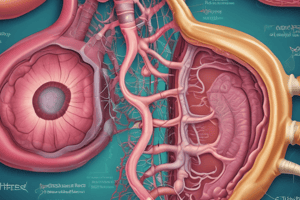Podcast
Questions and Answers
What is a common cause of acute pancreatitis?
What is a common cause of acute pancreatitis?
- Chronic alcohol abuse (correct)
- Infection by H.pylori
- Gallbladder dysfunction (correct)
- Stomach ulcer
Which test is specifically used to detect H.pylori antigens in stool?
Which test is specifically used to detect H.pylori antigens in stool?
- Urea breath test
- Fecal elastase-1 test
- Stool antigen test (correct)
- Hydrogen breath test
What is a characteristic feature of steatorrhea?
What is a characteristic feature of steatorrhea?
- Absence of carbohydrates
- Overly fibrous stools
- Presence of bile pigments
- Lipid presence causing oily stools (correct)
What happens to elastase-1 levels in patients with chronic pancreatitis?
What happens to elastase-1 levels in patients with chronic pancreatitis?
What is the primary function of the urea breath test for H.pylori?
What is the primary function of the urea breath test for H.pylori?
Which of the following disorders is NOT commonly associated with malabsorption syndrome?
Which of the following disorders is NOT commonly associated with malabsorption syndrome?
What indicates a lower GI bleed during screening?
What indicates a lower GI bleed during screening?
What outcome can result from the infection of H.pylori in the stomach?
What outcome can result from the infection of H.pylori in the stomach?
Flashcards
What is gastritis?
What is gastritis?
Inflammation of the stomach lining that can lead to ulcers. Common causes include H. pylori infection, irritants like alcohol and smoking, and Zollinger-Ellison syndrome.
What is H. pylori?
What is H. pylori?
A bacterium that can cause gastritis and stomach ulcers. It thrives in the acidic environment of the stomach by producing an enzyme called urease.
What is the Urea Breath Test?
What is the Urea Breath Test?
A test that measures the amount of carbon dioxide expelled from the lungs after ingesting urea. It confirms the presence of H. pylori by detecting urease, an enzyme specific to this bacteria.
What is Pancreatitis?
What is Pancreatitis?
Signup and view all the flashcards
What is Acute Pancreatitis?
What is Acute Pancreatitis?
Signup and view all the flashcards
What is Chronic Pancreatitis?
What is Chronic Pancreatitis?
Signup and view all the flashcards
What is Malabsorption Syndrome?
What is Malabsorption Syndrome?
Signup and view all the flashcards
What is the Sudan Stain Test?
What is the Sudan Stain Test?
Signup and view all the flashcards
Study Notes
Gastritis
- Gastritis is inflammation of the gastric mucosa, potentially leading to ulcers.
- Common causes include Helicobacter pylori infection, irritants (alcohol, smoking), and Zollinger-Ellison syndrome.
Helicobacter pylori (H. pylori)
- Causes both acute and chronic gastritis.
- Disrupts the gastric mucosal barrier.
- Survives in stomach acid by secreting urease, which neutralizes acid.
H. pylori Screening Tests
- Urea breath test: Detects H. pylori by measuring 14C released after urea breakdown (if H. pylori is present).
- Stool antigen test: Identifies H. pylori antigens in stool.
Pancreatitis
- Inflammation of the pancreas affects exocrine (digestive enzyme) function.
Acute Pancreatitis
- Acinar cells contain zymogens (precursors to digestive enzymes).
- Premature activation of zymogens causes self-digestion and inflammation.
- Digestive enzymes (amylase, protease, lipase) enter the bloodstream.
- Common causes include alcohol abuse and gallstones.
- Markers like WBC, TG, glucose, bilirubin, ALT, and CRP increase.
Chronic Pancreatitis
- Chronic inflammation and fibrosis damage acinar cells.
- Scar tissue formation disrupts acinar cells, reducing digestive enzyme production.
- A common symptom is steatorrhea (fatty stools).
- Low fecal elastase-1 levels are an indirect indicator.
Intestinal Disorders: Malabsorption Syndrome
- Malabsorption syndrome, characterized by steatorrhea, results from bile duct obstruction, chronic pancreatitis, or celiac disease.
- Sudan stain test: Positive (two layers) indicates lipid presence; negative (one layer) indicates absence of lipid.
Malabsorption Syndrome Diagnostic Tests
- Triolein breath test: Assesses fat malabsorption.
- Hydrogen breath test: Identifies carbohydrate malabsorption.
- Xylose absorption test: Evaluates carbohydrate absorption.
- Schilling test: Diagnoses vitamin B12 malabsorption.
Gastrointestinal (GI) Bleeding
Upper GI Bleeding
- Originates from esophagus to ligament of Treitz (e.g., peptic ulcers, duodenal ulcers, malignancy).
- Screening indicator: black, tarry stool (melena) due to hemoglobin digestion. 50ml or more blood loss.
Lower GI Bleeding
- Originates from colon, rectum, or anus (e.g., diverticulosis, hemorrhoids, anal fissures, malignancy).
- Screening indicator: hematochezia (fresh bloody stool).
- Fecal occult blood test (FOBT): Detects hidden blood in stool.
- Stool DNA test: Identifies abnormal DNA linked to colorectal cancer or precancerous polyps (e.g., KRAS, TP53 genes).
Studying That Suits You
Use AI to generate personalized quizzes and flashcards to suit your learning preferences.



